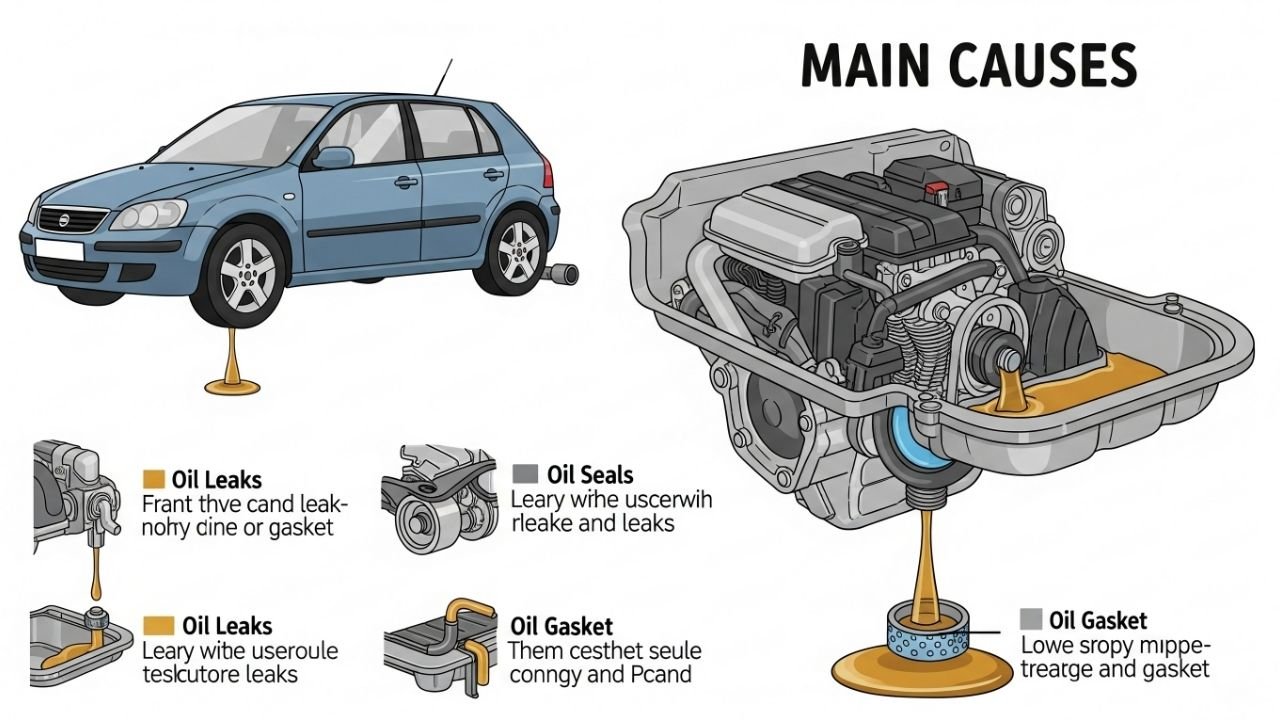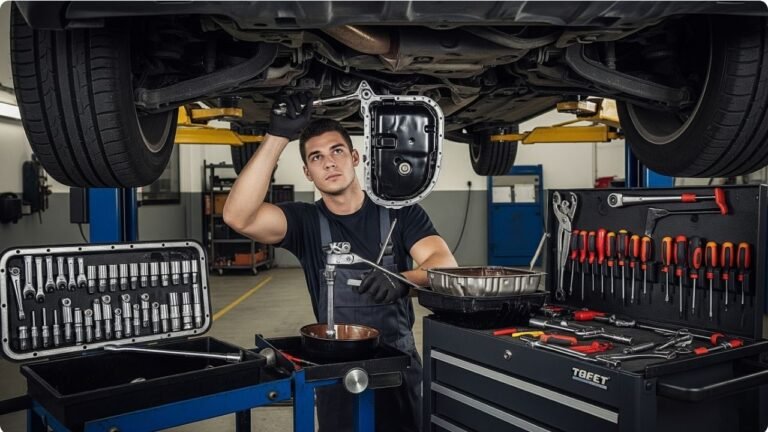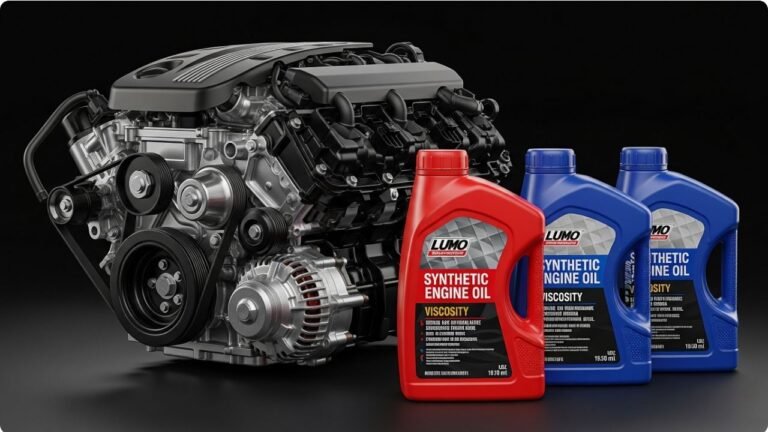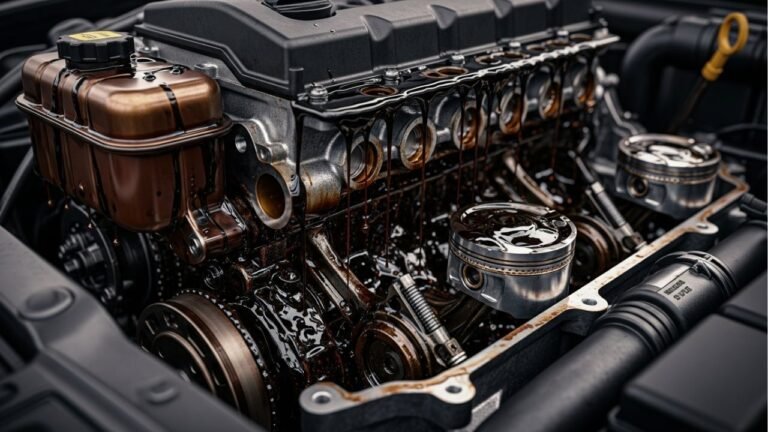Why Is My Car Leaking Oil When Parked? Understanding the Problem

Ever walked out to your car in the morning, only to find a dark puddle sitting quietly under it like a stain on your day? That little patch on the ground might not seem like much at first—but it can be your car’s way of crying for help. If you’ve been wondering, “why is my car leaking oil when parked?”, you’re not alone. It’s a common issue that drivers face, especially with older vehicles or those that haven’t had regular maintenance.
I’ve been there too. A few years ago, my old hatchback started leaving oil spots in the garage. At first, I ignored it, brushing it off as something minor. But as time went on, those spots got bigger—and so did my repair bills. That’s when I realized: ignoring an oil leak is like ignoring a fever. It won’t fix itself, and it often signals something serious under the hood.
This article will walk you through:
-
Why your car might be leaking oil when parked
-
The most common causes behind the issue
-
How to diagnose the problem yourself
-
Fixes you can try or request from your mechanic
-
FAQs that address what people often worry about
Let’s break it all down in a friendly, easy-to-read way—just like a good chat over tea.
The First Sign: Spotting That Sneaky Oil Leak
You may notice oil on your driveway, garage floor, or even under your usual parking spot. It often shows up as a dark brown or black puddle, sometimes with a rainbow sheen. And here’s the tricky part—it only appears when your car is parked. That’s usually the first clue.
Most people associate oil leaks with engine issues while driving. But sometimes, leaks only occur when the engine cools down and the pressure drops, allowing oil to seep from damaged seals or loose parts.
Here are a few signs your car is leaking oil when parked:
-
Small to large oil puddle under the engine bay
-
A burning oil smell after driving
-
A sudden drop in your oil level
-
Dashboard warning lights (especially the oil icon)
-
Dirty spots under your hood or on the lower engine
If you’re seeing these, it’s time to take a closer look.
Why Is My Car Leaking Oil When Parked? Main Causes Explained

| Cause | Description |
|---|---|
| Worn Out Gaskets | Rubber seals (like the oil pan gasket) break down over time. |
| Loose or Damaged Oil Filter | Oil filters not properly fitted can cause leaks when engine is off. |
| Faulty Drain Plug | A stripped or loose oil drain plug can cause slow leaks. |
| Valve Cover Gasket Failure | This gasket seals the top of your engine and can easily degrade. |
| Cracked Oil Pan | Hitting debris or curbs can damage the oil pan, leading to leakage. |
| Overfilled Engine Oil | Too much oil puts pressure on seals, making leaks more likely. |
| Damaged Oil Cooler Lines | These lines carry oil and can leak due to age or damage. |
We’ll go over each of these in more detail so you know what to look for and how to handle it.
The Role of Gaskets: Small Parts with Big Responsibilities
One of the top reasons for oil leaks is worn-out or cracked gaskets. These rubber or silicone seals are like little gatekeepers. They prevent oil from escaping its assigned path inside your engine. But as your car gets older, gaskets harden, crack, or simply fail due to heat and age.
Two main gaskets to look at:
-
Oil Pan Gasket: This one seals the oil pan to the bottom of the engine. A leak here usually results in a puddle under the center or front of the car.
-
Valve Cover Gasket: It sits on top of the engine and is prone to leaks as the rubber dries out.
I once had a valve cover gasket fail during a road trip. I didn’t even notice until smoke started rising from under the hood because oil was dripping onto the hot engine. It wasn’t dangerous, but it was definitely embarrassing—and costly.
Fix Tip: Gasket replacement is not too expensive, but it requires some labor. If you’re a DIYer with basic tools, it can be done at home.
Loose Oil Filter: A Common but Overlooked Issue
Here’s one most people don’t consider: a loose or damaged oil filter. After an oil change, if the filter isn’t screwed in just right, it might not seal properly. The result? A leak that gets worse when your engine stops running and oil settles.
What’s wild is that this happened to my friend after a DIY oil change. He didn’t use a filter wrench and hand-tightened it “just enough.” A week later, he noticed that same dark puddle in his driveway. A quick twist of the filter solved the problem.
What to check:
-
Is the oil filter tight?
-
Is there oil around the filter?
-
Was the rubber gasket removed from the old filter? (Sometimes it sticks to the engine)
Fix Tip: Always replace the oil filter during an oil change and ensure the new one is properly installed with a bit of oil on the rubber seal.
Oil Drain Plug: Tiny Bolt, Big Headache
The oil drain plug is the bolt at the bottom of your oil pan. When it’s loose, stripped, or has a worn washer, it can leak even when your car is parked. Since it’s low to the ground, even a small bump or rust can damage it.
I once had a car where the drain plug was overtightened, and it cracked the threads in the oil pan. The mechanic had to replace the whole pan—a pricey fix for a simple mistake.
Here’s what to look for:
-
Fresh oil around the plug
-
Signs of wear or rust
-
A soft or missing washer
Fix Tip: Always use a torque wrench to tighten the plug to spec. Never guess.
Oil Pan Damage: Not Just for Off-Roaders
If you’ve ever scraped the underside of your car on a high curb, pothole, or speed bump, you might have unknowingly cracked your oil pan. This is more common in low-clearance cars and in regions with poor roads.
The oil pan is made from aluminum or steel. While strong, it’s still vulnerable to impacts. When it cracks or the seal breaks, oil leaks out—slowly but steadily.
If your leak is near the front of your car and there’s a fresh puddle, the pan might be the problem.
Fix Tip: Small cracks can be patched temporarily with epoxy, but replacing the pan is the permanent solution.
Too Much of a Good Thing: Overfilled Oil
You’d think adding more oil would help, but too much oil can be just as bad as too little. Overfilling puts pressure on seals and gaskets. That extra oil has nowhere to go—and guess what? It starts leaking out, especially when the engine cools down and settles.
Here’s how I learned that the hard way: I once topped off oil without checking the dipstick properly. The next morning, I saw oil on the garage floor. A mechanic told me I’d caused the leak by overfilling.
Check this:
-
Is the dipstick showing above the “MAX” line?
-
Are you seeing white smoke from the exhaust?
-
Is there oil leaking from multiple spots?
Fix Tip: If you’ve overfilled, use an oil extractor pump or get a mechanic to remove the excess.
Table Summary: Symptoms & Solutions
| Symptom | Likely Cause | Suggested Fix |
|---|---|---|
| Puddle under the engine | Oil pan gasket | Replace gasket |
| Oil dripping after parking | Valve cover or oil filter | Tighten/replace |
| Burning smell when driving | Oil on hot engine | Check valve gasket, clean engine surface |
| Repeated low oil warning light | Multiple leaks or major one | Full inspection and professional repair |
| Fresh oil near oil drain bolt | Loose or stripped drain plug | Replace washer or repair threads |
Next Steps: Diagnosing and Fixing the Leak
Before rushing to the mechanic, there are things you can do at home to identify the leak:
Try this simple DIY method:
-
Clean the engine with degreaser
-
Park on a clean cardboard or paper overnight
-
Note the oil spot location
-
Check oil level the next morning
You’ll have a better idea of where the oil is coming from—and how serious the leak is.
Hardened Seals and Gaskets: Age Isn’t Just a Number
Cars, like people, show signs of aging. One subtle but serious symptom? Hardened seals and gaskets. As your car racks up miles and faces temperature shifts, the rubber components start to lose flexibility. They dry out, shrink, and eventually crack—just like an old pair of sneakers left out in the sun.
These aged seals can leak oil only after the engine cools down. That’s why your driveway might be spotless when you return from work, but the next morning you spot an oily surprise.
I once had a 15-year-old Toyota that ran perfectly but kept leaking tiny drops overnight. It turned out the rear main seal had hardened and was leaking oil slowly. It wasn’t a dangerous leak yet—but it could’ve led to a seized engine if ignored.
What you can do:
-
Use high-mileage oil with seal conditioners.
-
Inspect seals during regular servicing.
-
Be proactive about replacing aging components.
Damaged Oil Cooler Lines: Thin Lifelines That Matter
Some cars, especially performance models or those with turbochargers, have oil cooler lines. These lines carry hot oil to and from the radiator to maintain proper temperature. But over time, exposure to heat and vibration can cause these hoses to crack or leak.
The tricky part is that they may not leak under pressure while driving. But once you stop and the engine cools, oil begins to seep out—usually showing up the next day as a thin, dark smear under the engine.
Signs of cooler line leaks:
-
Leak coming from the side of the engine
-
Small trail of oil down the undercarriage
-
Slight burning oil smell
Fix Tip: Cooler lines can be replaced individually. It’s a smart move to upgrade to braided lines if you live in hot climates or drive aggressively.
The Weather Factor: Cold Mornings and Oil Leaks
Here’s a little-known truth: weather affects oil leaks. Cold temperatures can cause rubber seals and gaskets to contract slightly. When your car is parked overnight in the cold, this contraction can allow small amounts of oil to escape—only to seal back up when the engine warms.
This happened to me one winter in Dhaka. I noticed oil under my car only on the coldest mornings. Turned out the valve cover gasket had just enough shrinkage from the chill to let oil sneak out.
If this sounds familiar:
-
Consider switching to a slightly thicker oil grade in winter.
-
Use a garage or cover to reduce overnight temperature swings.
-
Monitor the leak—if it worsens, it may be time for replacement.
Preventing Oil Leaks: Best Practices to Keep Your Driveway Clean
Now that we’ve covered the reasons why your car leaks oil when parked, let’s shift gears and talk about how to prevent it. You don’t have to be a mechanic to take care of your car—you just need some smart habits.
Best tips for prevention:
-
Regular oil changes using quality oil and filters
-
Visual checks under your car every few weeks
-
Look for oil loss on your dipstick—especially after long drives
-
Inspect gaskets and seals during scheduled maintenance
-
Never overfill oil during top-ups
Recommended schedule:
| Task | Frequency |
|---|---|
| Check oil level | Every 2 weeks |
| Oil & filter change | Every 3,000–5,000 km |
| Inspect for leaks | Monthly |
| Professional check-up | Every 6 months |
Little routines can save you from big repair bills.
Real-Life Story: My Costliest $5 Mistake
Here’s a personal story that might help it all stick.
I once bought a cheap aftermarket oil drain plug for about $5 because the original one had a slight bend. “What’s the harm?” I thought. A few days later, after a long highway drive, I parked at my cousin’s wedding. The next morning, a giant oil stain greeted me like an unwelcome guest. That $5 plug didn’t fit right and let out nearly half of the oil overnight.
We had to tow the car to a local mechanic in formal clothes. My suit still had grease on it. Lesson learned: Always invest in proper parts and don’t cut corners with your engine.
Frequently Asked Questions (FAQs)
1. Is it safe to drive if my car is leaking oil when parked?
It depends on the size of the leak. Small leaks might not be urgent, but driving with a major oil leak can cause engine damage. Check your oil level often and visit a mechanic if the leak grows.
2. How can I tell if the leak is engine oil or something else?
Engine oil is usually dark brown or black, with a slippery feel. Transmission fluid is red, coolant is green or orange, and brake fluid is clear to light yellow. Smell and color help identify the fluid.
3. Can an oil leak go away on its own?
No. Oil leaks rarely fix themselves. In fact, they usually get worse over time. Early detection can save you from expensive engine repairs.
4. Will an oil stop-leak additive work?
Additives can temporarily reduce small leaks, especially in older engines. But they are not a permanent solution and shouldn’t be used in place of proper repairs.
5. How much does it cost to fix an oil leak?
It depends on the source. Simple gasket or filter fixes can cost $50–$200. Bigger repairs like oil pans or main seals may range from $500 to $1,200.
6. Does weather affect oil leaks?
Yes! Cold weather can shrink seals and increase leak chances. Using appropriate oil grades for your climate can help.
7. Can I patch an oil pan myself?
For small cracks, yes. Epoxy patches or metal sealants can work temporarily. But it’s better to replace the pan for long-term safety.
8. Will my car fail inspection with an oil leak?
In many areas, yes—especially if it’s a large leak or dripping onto hot parts. It’s considered a safety hazard and must be fixed to pass emissions or roadworthiness tests.
Final Thoughts: Don’t Let a Leak Turn Into a Disaster
If you’ve ever asked, “why is my car leaking oil when parked?”, now you know it’s more than just an inconvenience. It’s a warning sign—a whisper from your engine that something needs attention. Ignoring it won’t make it go away. But listening to your car, learning from it, and taking action can save you stress, money, and time down the road.
Cars are like friends—they need care, attention, and a little patience. Whether it’s a loose bolt, a brittle gasket, or a rookie mistake with a filter, every leak has a story. And every fix adds to your confidence as a car owner.
So next time you see that little dark puddle under your car, smile. You’ve got the knowledge now. And you’re ready to handle it like a pro.






